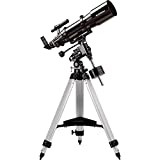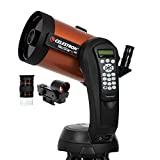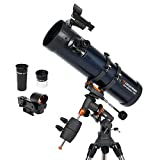Astronomical telescopes – Buying guide & Comparison
If you’re short on time and you just want to find the best astronomical telescope, this short paragraph should help you get exactly the model you need. According to our research, the Orion AstroVIew 120ST is the best model for sale because it comes with a 120mm aperture that is ideal for viewing deep space objects and when it is combined with the long focal length celestial bodies appear sharp and clear. Since it comes with an equatorial mount you can easily track objects in the night sky, and the Starry Night software ensures you know exactly what you are viewing. If the Orion AstroView is not available, your second option should be the Celestron NexStar 6 SE.
Comparison table
 Our Top Choice
Our Top Choice
The 120mm aperture of this choice is the first benefit you might have to consider as it will allow you to look at a wide array of celestial objects, including deep-sky ones like nebulas and galaxies. The software provided by the manufacturer, as well as the focuser will both help you do your job correctly and comfortably.
Several beginners have pointed out that the price point of the 9005 might be a tad difficult to digest for people looking for inexpensive telescopes.
With its convenient equatorial mount and other handy features, you’ll probably find the Orion 9005 a most trustworthy friend in need.
 2nd Best
2nd Best
As one of the critically acclaimed choices available for sale these days, it would have been natural for the NexStar 6 to boast an altazimuth mount. The 6-inch telescope can ensure that the pictures you’ll be able to take a peek at will appear both clearly and brightly. The Celestron database s also worth adding.
The battery life might be an inconvenience for some owners as the standard batteries utilized by this model might not be able to last for a very long time.
As the model is a powerful, heavy, and big telescope that boasts high-end optics, it’s entirely worth its weight in gold.
Also To Consider
The 31045 AstroMaster is a particularly versatile unit that boasts a 130mm aperture. The celestial objects that you’ll be able to look at will appear as clear as possible. The lightweight construction of this model enables enhanced portability. A handy software is included in the deal, as well.
Some owners say that it took them quite a deal of time in order for them to be able to finally put together the telescope. The instructions could have been clearer.
Since it’s budget-friendly and a winner in terms of versatility, the Celestron 31051 is a great choice for most consumers.
Whether you are just getting interested in astronomy or are already familiar with the various stars and planets, it is important to have the right telescope. There are several types to choose from and unless you know exactly what you need, making the right decision can seem overwhelming. In this buying guide we have included informative tips that will make it a little easier for you to pick the best stargazing telescope.
Aperture and Magnification
According to the best astronomical telescope reviews one of the most important features to consider is the size of the aperture. This will determine how bright and sharp your view is, and whether you can see deep space objects or only those closer to Earth. Larger apertures gather more light and allow for more magnification. This is usually done by changing out the eyepieces. If there isn’t enough light gathered, even using a high magnification will be pointless since distant objects will still appear faint and blurry. Most experienced astronomers agree that it is always best to pick a telescope with the largest aperture your budget will comfortably allow.
Types of Mounts
The mount on a telescope is often overlooked by beginners, and this is a mistake. Even a telescope with the best optics will be basically useless if it comes with a cheaply constructed mount. In order to track celestial and even terrestrial objects the mount needs to be sturdy, stable and able to work smoothly. There are a few types of mounts to choose from, and each comes with its own advantages.
The best astronomy telescope for beginners often comes with an equatorial mount. They can easily be motorized, and this is always a benefit for astronomers just starting out. These mounts are also considered the easiest to operate operate since you can track objects using only one axis. Altazimuth mounts are lighter in weight, but are considered to be a little harder to operate. It is also more difficult to motorize these mounts, and this can affect the performance of the telescope. There are also Dobsonian mounts which are incredibly easy to set up, lightweight, and typically priced to fit almost any astronomer’s budget.
Telescope accessories
Telescopes can come with a surprising array of accessories and some can dramatically improve your experience. Models that come with one or more eyepieces allow you to view objects up close and at a distance. Some telescopes also come with a Barlow lens which can provide you with extra magnification. Finders are a convenient extra that beginners should carefully consider since it makes it a little easier to locate an object in the night sky. Included tripods are always a convenient extra, and provide a stable base. Beginners and experienced astronomers will also appreciate models that come with software or provide access to an information database. This way you will always know exactly what you are viewing.
5 Best Astronomical Telescopes (Reviews) in 2024
With the right telescope you will able able to see the landscape on Mars and even distant galaxies and nebulas. While we can’t choose the right model for you we can help you make an informed decision, which is why we have the best astronomical telescopes showcased below.
Contents
1. Orion 9005 AstroView 120ST Equatorial Refractor Telescope

It also comes with Orion’s “Starry Night” software so you will know exactly what you are viewing in the night sky.
Thanks to the 120mm aperture even faint, distant objects will appear bright and clear when they are magnified. When this is combined with the 600mm focal length galaxies, stars and nebulas will come sharply into view.
The finder scope makes it easy for you to locate an object in the sky, and you also have the benefit of the 2” rack and pinion focuser.
The equatorial mount ensures a smooth operation, which is always an advantage when you are tracking objects across the sky. It even comes with a sturdy tripod that can be adjusted for height.
Pros
This is a wide-field refractor telescope that allows you to view star clusters, nebulae, and other expansive celestial phenomena with ease.
You can view deep-sky objects while enjoying clear resolution with exquisite light-gathering capability from the 4.7-inch aperture and 600mm focal length.
The tripod adjusts in height to enable you to experience comfortable viewing and a customized observation level.
The equatorial mount comes with slow-motion controls for smooth tracking so you can follow celestial targets as they move from one end of the sky to the other.
The internal polar alignment scope delivers a precision performance so the instrument is able to ensure that observation reference points are accurate for pinpointing of targets at their exact positions.
Cons
The rack-and-pinion focuser comes with some backlash, according to one customer who is quite knowledgeable about telescopes and who did a comprehensive review of this model. However, the buyer believes that with adequate quality control, this unit should be able to overcome that issue.
Buy from Amazon.com
2. Celestron 11068 NexStar 6 SE Computerised Telescope

All you have to do is press a button and the telescope will automatically located thousands of stars, planets, nebulas and other celestial bodies in the sky. This also makes it extremely easy to track objects as they are moving.
Since this telescope is designed to be portable it is lightweight, and incredibly easy to set up. The 6 inch Schmidt-Cassegrain optics ensure that objects appear bright and clear, especially when it is combined with the 1500mm focal length.
Thanks to the “SkyAlign” technology you can align the telescope quickly and easily, and the finderscope makes it a breeze to locate celestial objects. You also have access to Celestron’s expandable database so you will always know exactly what you are looking at.
Pros
The StarBright XLT high-transmission coatings that come standard in this instrument ensure adequate light gathering capacity so you can view celestial objects with amazing clarity every time.
The StarPointer finderscope facilitates the effortless alignment of the telescope as well as the accurate locating of objects.
The SkyAlign feature enables the accurate pinpointing of any three brilliant celestial objects in the sky for alignment that is quick and stress-free.
For convenience, the telescope comes with a quick-release fork arm mount, an optical tube, and an accessory tray for simplified setup and to keep things within easy reach.
With its massive database, the telescope provides access to information about 40,000 objects in the deep sky along with 200 user-definable objects and in-depth information on more than 200 objects.
Cons
It can be difficult to align the telescope if you live in a suburban, bright sky area with a light -polluted level or a restricted field of view.
Buy from Amazon.com
3. Celestron 31045 AstroMaster 130EQ Reflector Telescope

The 130mm aperture ensures objects are bright and clear whether they are up close or at a distance.
You will appreciate how simple this telescope is to set up, and its lightweight construction makes it relatively easy to take with you. Thanks to the German equatorial mount you can enjoy a smooth operation, and easy tracking. This also makes it easier to accurately locate objects, especially when it is combined with the permanently attached Starpointer.
The tripod even comes pre-assembled so there is one less thing for you to do, and it is designed to provide a secure and stable base. With “The Sky” software included and priced to fit most budgets, the AstroMaster might be the perfect telescope for you.
Pros
This telescope features a quick and effortless tool-free setup so it can be up and ready for deep-sky exploration in less time.
The permanently-mounted StarPointer allows you to align the telescope well enough for an in-depth exploration of the deep sky.
The erect image optics makes the scope suitable for astronomical and terrestrial use by ensuring that images are perceived through your eyes in the proper orientation for comfortable viewing.
The quick-release dovetail attachment allows the easy mounting of the scope to the supplied tripod for stability and supported viewing.
The German equatorial mount enables you to track objects in motion in the night sky so the scope moves smoothly from one side to the other and up and down to follow the motion of the target.
Cons
Although the RA adjustment is smooth, one user applied silicon grease to make the declination adjustment less difficult to use.
Buy from Amazon.com
4. Orion 09007 SpaceProbe 130ST Equatorial Reflector Telescope

The SpaceProbe by Orion is designed to travel with you, and only weighs 27 pounds fully assembled.
It comes with everything you need to get started, and you will love its performance capabilities.
This reflector telescope comes with a 5.1 inch aperture that ensures distant objects are bright and clear.
To ensure easy portability the optical tube only measures 24 inches, but with a fast f/5 focal ratio you are not sacrificing performance for size.
The finderscope makes it easy to accurately located objects in the sky, and you will also know exactly what you are seeing thanks to the “Starry Night” software. It also boasts an equatorial mount for a smooth performance.
Pros
This reflector telescope is ideal for the avid stargazer just starting on deep-sky exploration, and also makes a great choice for intermediate-level astronomy enthusiasts.
This relatively compact telescope weighs in at just 27 pounds when assembled so it is easy to transport and store or travel with.
The instrument makes a great complement to a large Dobsonian scope thanks to the short optical tube design, f/5 focal ratio, and wide-field viewing angle.
The EQ2 mount enables the easy tracking of celestial objects that seem to move across the expanse of the night sky for intensive observation.
The aluminum tripod is lightweight but strong to enable you to fix the scope at a comfortable viewing height. It comes with an accessory tray that allows you to keep your telescope essentials handy at all times.
Cons
The equatorial mount has its RA slow motion knob on the viewing side so when you are tracking objects, you are basically turning a gear for the motor knob instead of the scope fine-tuning adjustment.
Buy from Amazon.com
5. Orion 10015 StarBlast 4.5 Astro Reflector Telescope

Best of all this telescope comes at a price that will fit almost any astronomer’s budget.
The 4.5 inch aperture ensures that objects appear bright and clear, and it comes with two eyepieces for easy magnification.
The “EZ” finder scope makes it a breeze to locate objects in the sky, and thanks to the “Starry Night” software you will always know what you are looking at.
Best of all this telescope comes pre-assembled so you can get started right out of the box. With a altazimuth mount for a smooth performance, there really isn’t anything not to like about this affordable telescope.
Pros
The telescope is a compact instrument perfect for beginner and astronomy enthusiasts who need a quality scope for deep-sky observation and exploration.
The large 4.5-inch aperture works nicely with the speedy f/4 focal ratio to deliver detailed and sharp views of the Moon, planets, and other objects in the solar system, along with nebulae, the constellations, and other wide-field celestial targets.
The stable tabletop base brings seamless altazimuth motion to enable you to track celestial objects manually and with adequate precision.
The two supplied Explorer II 1.25-inch Kellner eyepieces deliver low and high power viewing so you can get as much resolution as you need.
The EZ Finder II reflex sight facilitates the easy aiming of the scope toward the celestial object of choice so you won’t need to do error-prone guesswork.
Cons
The height tension adjustment knob can be tricky to work as you might not be able to tighten it all the way.
Buy from Amazon.com










